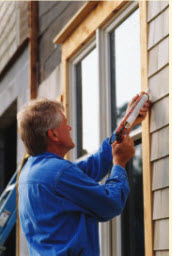
Caulk is Cheap – Use It to Plug Those Leaks and Save!
You would be absolutely amazed to know how much air comes in and leaves your house every hour of every day. The average house has .75 air changes per hour, which means 75 percent of the air in an average house leaks out every hour and is replaced with outside air.
 Remember, the same laws and principals that say heat rises and cold falls also say that hot moves to cold, and wet moves to dry. So, in the summer, warm, moist air is fighting to get into
your house, and in the winter, warm moist air is fighting to get out of your house. It’s called infiltration and exfiltration.
Remember, the same laws and principals that say heat rises and cold falls also say that hot moves to cold, and wet moves to dry. So, in the summer, warm, moist air is fighting to get into
your house, and in the winter, warm moist air is fighting to get out of your house. It’s called infiltration and exfiltration.
This leaking is caused by tiny cracks in the ceilings, floors, walls, windows, and doors. Does your house get drier and drier in the winter, until your skin dries out and itches? As that warm, moist air leaks out, it is replaced by cold, dry air coming in.
With Georgia’s weather extremes, the more your house leaks, the drier (more uncomfortable) it becomes in the winter, and the moister (more uncomfortable) it becomes in the summer.
All this leaking is enhanced by positive and negative pressure from within and outside your home that can occur due to wind, unbalanced supply and return in central air systems, and by the stack (or chimney) effect inside the walls and living space of your home. These are just a few of the ways leaks are enhanced.
YOU’VE GOT TO STOP THOSE LEAKS!
Caulk and spray foams are cheap, effective weapons in this battle for comfort and energy savings. Every article about saving energy tells you that caulking around windows and doors is the simplest way to keep air from leaking into and out of your home. That is probably true.
But, the most effective way to stop air leakage is more complicated and may require a professional contractor. It involves sealing from the top down and includes sealing around all wiring and plumbing penetrations in wall tops and around light fixtures (especially recessed can lights), vent fans and HVAC vents in the ceiling.
By starting to seal at the top, you quickly reduce the stack effect inside your house, gaining the most return on your caulking buck. Naturally sealing both ends is better, so if your house has a crawl space, you will want to seal the wiring and plumbing penetrations into the living space from below as well.
More Energy Savings Tips:
Replace air filters regularly for efficient heating and cooling.
Auditing Energy: Small Measures, Real Savings.
Lighting choices to save you money.
FREE PDF - Energy Savers: Tips on saving money & energy at home
Do-it-yourselfers, please read on. Here are some simple instructions for using caulk around your home to keep your expensive air-conditioned or heated air indoors, where it belongs – and the outdoor weather outside.
Buy the caulk. You’ll find it at the hardware store in a plastic or card-board tube or cartridge. If you want to paint the caulk to match your window frames, buy a brand that’s paintable. If you want to do the job less often, silicone might be a better choice, as it’s less prone to cracking. It’s not paintable, but it comes in a variety of colors. You’ll use about a half cartridge per window.
Buy a caulk gun. Slip the tube of caulk into the gun to make it easier to work with. Applying caulk directly from the tube is a headache, unless you’re just filling in a tiny area. You can buy a caulk gun at a hardware or paint store for less than $15.
Decide where you will caulk. Any hole, gap, crack, or opening on the inside or outside of your house needs caulking, including around windows and doors, exterior light fixtures, outdoor taps and openings for exhaust fans and where cable and phone lines enter.
Load your caulk gun. Slide the tube of caulk into the caulking gun. Snip the tip off the tube, making as small a hole as possible, so you can control the amount of caulk that squeezes out. Secure the tube snugly into the gun.
Prepare the surface. Scrape away old caulk, dirt, and loose paint from the area you will caulk. You will apply the caulk between the window frame and the stucco or siding on the outside of your house, or at the joint between the frame and the drywall indoors.
Apply the caulk. Hold the gun at a 45-degree angle and squeeze a small bead of caulk into the tiny line that separates the window frame from the stucco, brick or siding. Use your finger to smooth the caulk into that tiny opening. Repeat the process all the way around the window frame.
Let the caulk dry for 24 hours, and then paint it to match your window frame.
Repeat the process
on any gap or crack that exposes your home to the outdoor weather. You’ll save more on your energy bill than you spent on the equipment.